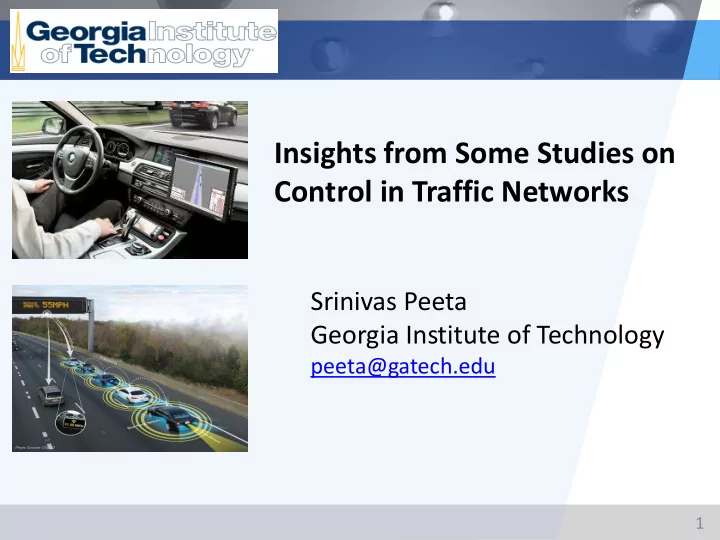

Insights from Some Studies on Control in Traffic Networks Srinivas Peeta Georgia Institute of Technology peeta@gatech.edu 1
Transportation Ecosystem Infrastructure Human Vehicle 2
Transportation System Supply Demand Technology 3
Control in Networks: Some Studies ❑ Real-time dynamic traffic network control ▪ Time-dependent conditions ▪ Stochasticity: demand, supply ▪ Technology: Role of information ▪ Traveler behavior ❑ How information/connectivity can be used to manage networks and their performance ▪ Congested traffic networks ▪ Disaster response – planning and operations ▪ Connected and/or autonomous transportation ▪ Collaborative freight networks ▪ Organizational networks 4
Modeling Challenges ❑ Realism ▪ Traffic flow characteristics (analytical, simulation) ▪ Travel behavior (departure time/route/mode, learning & evolution, familiarity, risk-taking) ▪ Driver behavior (familiarity, experience, aggressiveness) ❑ Factors ▪ Heterogeneity (traveler/driver/human/vehicle) ▪ Stochasticity (demand/supply) ▪ Time scale (behavior/planning/operations) ▪ Interactions (vehicle-human-infrastructure) ❑ Goals ▪ State (description, prediction, evolution) ▪ Performance and control 5
Modeling Challenges ❑ Mathematical properties ▪ Realism in modeling vs mathematical tractability ▪ Complexity of traffic flows ▪ Traveler behavior and learning ▪ Stochasticity, heterogeneity, dynamics ❑ Computational time ▪ Real-time needs ▪ Tradeoffs with accuracy ▪ Sensitivity issues under emerging technologies 6
Emerging Technologies ❑ Connectivity ▪ Reliability ▪ Congestion ▪ Control ▪ Security ❑ Automation ▪ Stability ▪ Mixed flows ▪ Platooning ▪ Traffic characteristics ▪ Safety and mobility 7
Needs ❑ Human-vehicle interactions ▪ Transition of control ❑ In-vehicle interactions ▪ In-vehicle devices ▪ Mobile apps ❑ Motion planning ▪ Maneuvering ▪ Platooning ▪ Intersections ❑ Connectivity-based control ▪ In-vehicle/personal devices 8
Needs ❑ Transition and mixed traffic flows ▪ Level of automation ▪ Level of connectivity ▪ Vehicle characteristics ▪ Asymmetry in human behavior ▪ Differences in human and machine approaches to driving ▪ Misperception of AV capabilities ❑ Data ▪ What does it reveal? ▪ How to connect disparate data? ▪ How can it be used to enhance modeling realism? ▪ Human in the loop 9
Insights: Some Problems Addressed ❑ Platooning ▪ Cooperative braking control (CVs) ▪ Under V2X communications ▪ CV information transmission time delays ❑ Vehicular traffic flow ▪ Sliding mode controller ▪ Non-lane discipline ▪ Leveraging vehicle characteristics under connecitvity 10
Insights ❑ Transportation community ▪ Control as a goal enabler ▪ Effectiveness, goals (mobility, safety, energy, emissions) ▪ Vehicular interactions (behavior, traffic flow theory) ▪ Car-following, merge/diverge, ▪ Network-level ▪ Traffic interactions, traveler/driver behavior, topology/infrastructure effects ❑ Control community ▪ Focus on controller and its properties ▪ Convergence, stability, consensus ▪ Vehicle as individual agent (inter-vehicle gap, velocity) ▪ Negative spacing/velocity, uncomfortable acceleration/deceleration ▪ Micro- and corridor-level ▪ Lateral control, longitudinal control 11
Opportunities ❑ Value in collaboration ▪ Increased role of technology, especially automation, as a catalyst ▪ Data as enabler (Google, Nvidia, etc.) ▪ Focus on realism Infrastructure Human Vehicle 12
Thank you! Contact Information: Srinivas Peeta Email: peeta@gatech.edu Popular Mechanics, 1950s
Recommend
More recommend